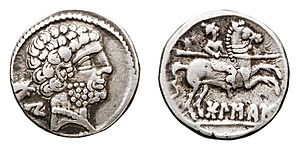Bolskan facts for kids


Bolskan was an ancient city in what is now north-eastern Spain. It was home to the Vescetani, an Iberian tribe. This old city was located about 65 kilometers (about 40 miles) north of the Ebro River. Today, the modern city of Huesca stands exactly where Bolskan used to be, in the Iberian Peninsula.
Around 179 BC, the land where the Vescetani lived was changed by the Romans. A Roman leader named Terentius Varro C. was involved in this. After this, the old Iberian city of Bolskan was rebuilt and given a new name: Osca.
Contents
Discovering Ancient Bolskan: A City's History
Bolskan was a very important city long ago. It was known for its people, the Vescetani, who were part of the larger Iberian tribes. These tribes lived in the Iberian Peninsula before the Romans arrived. Bolskan was a busy place, likely with its own leaders and ways of life.
From Bolskan to Osca: A Roman Transformation
The arrival of the Romans changed many things in ancient Spain. In 179 BC, the Romans took control of the area where Bolskan was located. They didn't just conquer the city; they rebuilt it. This was a common practice for the Romans. They often renamed cities and made them part of their growing empire. Bolskan became Osca, and it continued to be an important place under Roman rule.
Bolskan's Famous Coins: A Glimpse into the Past
Bolskan is especially famous for the many coins it produced. It had its own mint, which was like a factory for making money. These coins tell us a lot about the city and its people.
Early Bolskan Coins: Iberian Art
The first coins from Bolskan are very interesting. On one side, they show a bearded man facing right. We don't know exactly who this man was. On the other side, there's a horseman carrying a spear. You can also see the city's name written in an ancient Iberian language. These coins are a great example of Iberian art and writing.
Later Osca Coins: Roman Influence
Things changed around 37 BC, when Bolskan became Osca. The new coins looked different. They were still silver coins called Denarii. But now, they had Latin words on them. One side said "OSCA," which was the city's new Roman name. The other side had Latin words like "DOM. COS. ITER. IMP." These words were titles for important Roman leaders. Finding these coins helps historians understand how Roman culture spread.
Where to See Bolskan and Osca Coins
You can find examples of both the older Bolskan coins and the newer Osca coins in famous collections. The British Museum, for example, has many of these ancient coins. They are a valuable part of its collection of Iberian coins.
See also
 In Spanish: Bolskan para niños
In Spanish: Bolskan para niños

